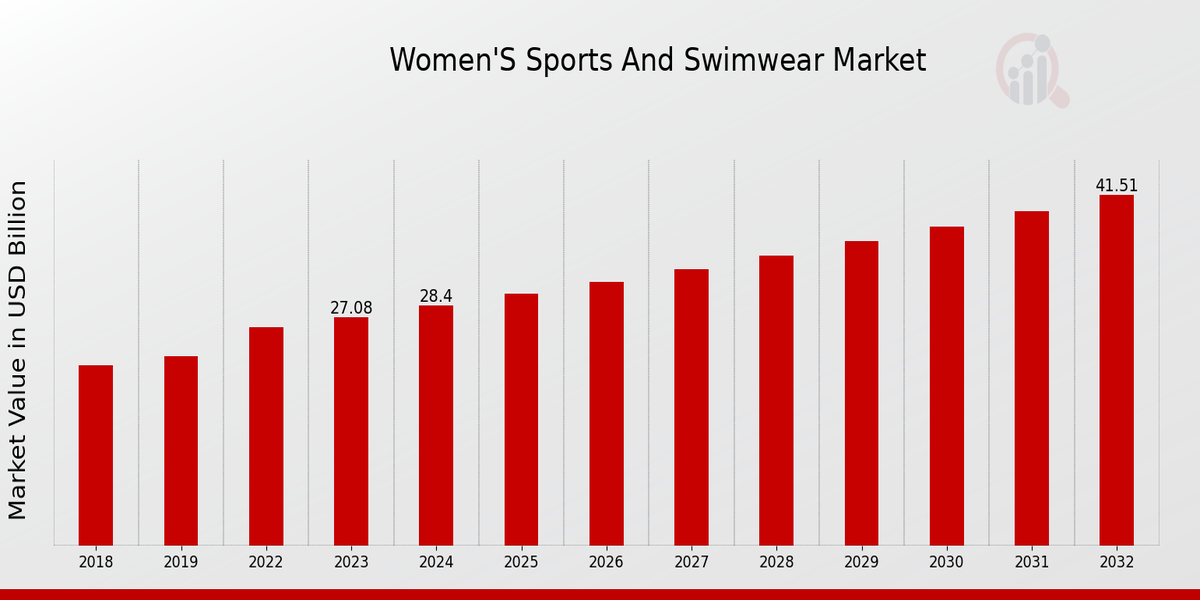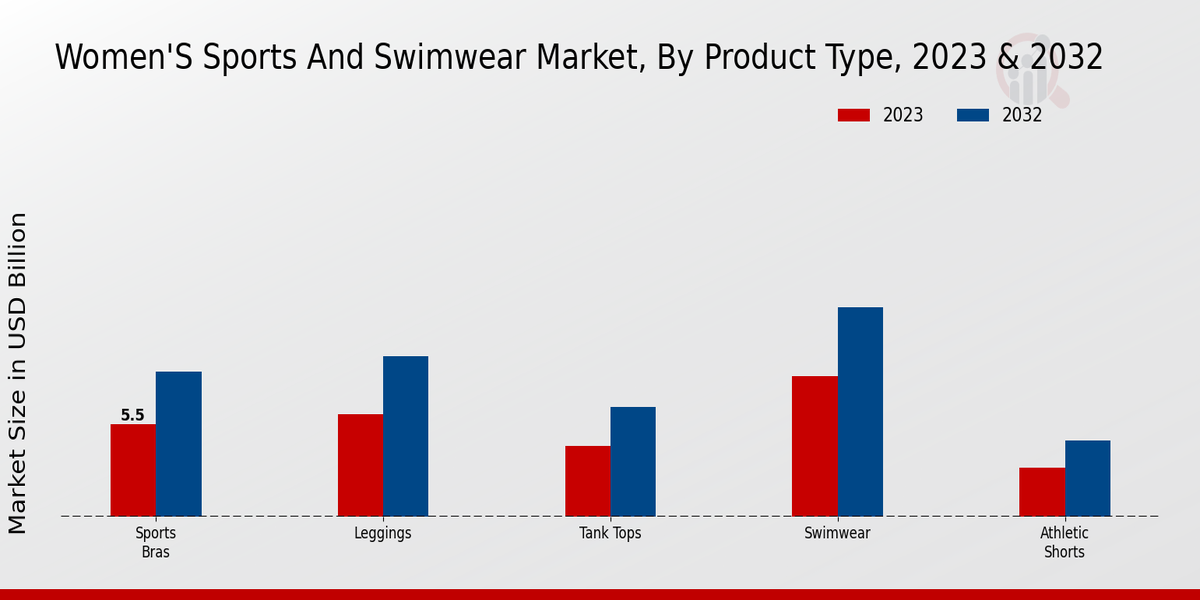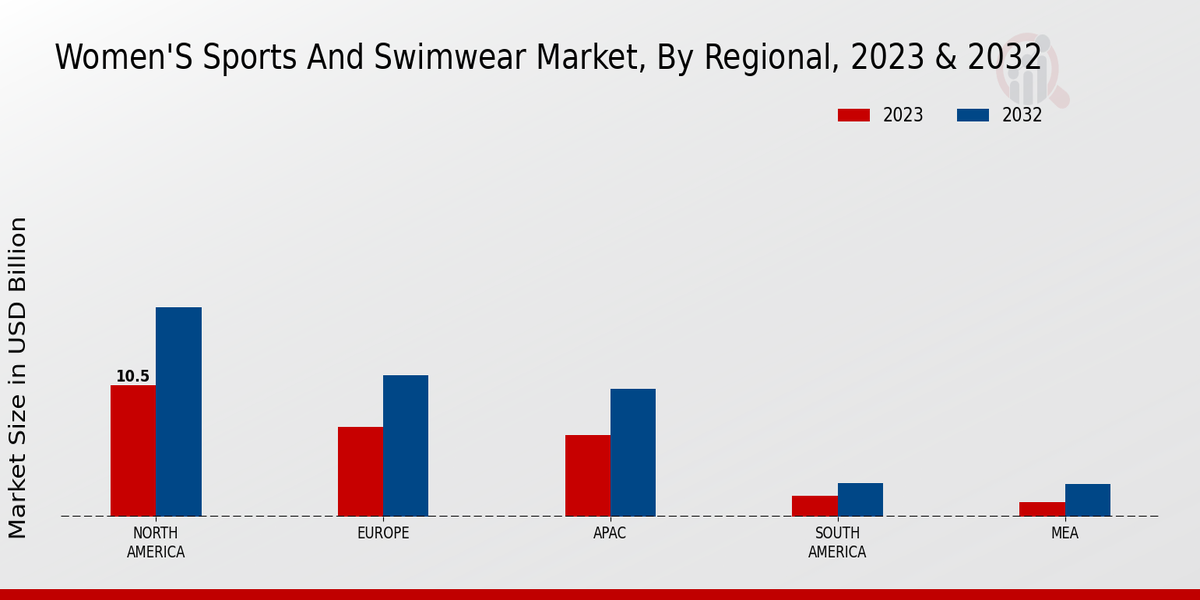Global Women's Sports and Swimwear Market Overview
Women's Sports and Swimwear Market Size was estimated at 25.83 (USD Billion) in 2022. The Women's Sports and Swimwear Market Industry is expected to grow from 27.08(USD Billion) in 2023 to 41.5 (USD Billion) by 2032. The Women's Sports and Swimwear Market CAGR (growth rate) is expected to be around 4.86% during the forecast period (2024 - 2032).

Source: Primary Research, Secondary Research, MRFR Database and Analyst Review
Key Women's Sports and Swimwear Market Trends Highlighted
The Women’s Sports and Swimwear Market is witnessing significant growth driven by an increasing focus on health and fitness among women. As more women engage in sports and outdoor activities, the demand for functional yet stylish activewear has surged. The rise of social media has played a crucial role in this trend, as influencers and athletes inspire women to embrace an active lifestyle. Additionally, brands are recognizing the importance of inclusivity, offering a wider range of sizes and styles that cater to diverse body types, which further boosts market appeal. Opportunities within the market are ripe for exploration, particularly in eco-friendly materials and sustainable production practices.
Consumers are becoming more environmentally conscious, creating a demand for products that align with their values. Brands that provide transparent sourcing and ethical manufacturing processes can capture this growing segment. Furthermore, the popularity of athleisure wear is paving the way for innovative designs that seamlessly transition from workouts to casual outings, allowing brands to expand their offerings. Recent trends indicate a shift towards personalized shopping experiences, with companies utilizing technology to provide custom-fit options and virtual try-ons. Collaborations with athletes and popular culture figures are also gaining traction, enhancing brand visibility and reaching wider audiences.
Overall, the Women’s Sports and Swimwear Market is transforming as it adapts to the changing preferences of modern consumers, paving the way for continued growth and diversification in the coming years.
Women's Sports and Swimwear Market Drivers
Rising Participation of Women in Sports and Fitness Activities
The increase in the number of women participating in sports and fitness activities is a significant driver for the Women’s Sports and Swimwear Market Industry. More women are engaging in physical activities such as running, yoga, swimming, and team sports. This trend can be attributed to several factors, including the growing awareness of health and wellness, government initiatives promoting female sports participation, and the influence of social media in encouraging active lifestyles.
As women become more health-conscious, they prioritize functionality and comfort in their sportswear and swimwear, leading to a growing demand for innovative and stylish options. The rise of fitness influencers and female athletes has also contributed to this growth by promoting a positive image of women in sports and motivating others to participate. Moreover, the expansion of sports leagues and fitness programs specifically designed for women has created a robust framework that supports and encourages female participation.
As more brands recognize this shift, they are focusing on developing high-quality, performance-driven sportswear that caters specifically to women. This market driver is crucial for the growth of the industry, ensuring that brands constantly innovate to meet the evolving needs and preferences of female consumers. As a result, the Women’s Sports and Swimwear Market Industry is poised to benefit from this increasing engagement of women in physical activities, fostering a culture of fitness and health that reverberates across multiple sectors.
Growing Trend of Athleisure
The popularity of the athleisure trend is significantly impacting the Women’s Sports and Swimwear Market Industry. Athleisure, characterized by clothing designed for athletic performance that is also stylish enough for casual wear, has opened new avenues for women's sportswear and swimwear brands. Women are increasingly looking for versatile clothing that seamlessly transitions from workout sessions to everyday activities without sacrificing style.
This shift toward athleisure has led to increased innovation in fabric technology, with brands focusing on comfort, breathability, and flexibility. As companies respond to consumer demand for multifunctional garments, the incorporation of fashion-forward designs into sports and swimwear lines becomes crucial in attracting a broader audience.
Increased Investment in Women's Sports Programs
There is a noticeable increase in investment and sponsorship in women's sports programs globally, which is nurturing growth within the Women’s Sports and Swimwear Market Industry. More organizations, corporate sponsors, and sports bodies are recognizing the potential of women's sports, leading to enhanced visibility and interest in female athletes. This increase in investment not only helps in developing female sports talent but also boosts the demand for specialized sports and swimwear that cater specifically to women athletes, further fueling market growth.
Women's Sports and Swimwear Market Segment Insights
Women's Sports and Swimwear Market Product Type Insights
The Women’s Sports and Swimwear Market showcases a diverse range of product types, reflecting the growing interest in women’s fitness and leisure activities. In 2023, the market revenue was valued at 27.08 USD Billion, with notable segments contributing to this robust figure. Sports Bras, valued at 5.5 USD Billion, hold significant importance as they offer the necessary support for physical activities, making them essential for active women. Leggings closely follow, with a valuation of 6.1 USD Billion, which reflects their popularity for both workouts and casual wear, contributing to their majority holding within the market.
Tank Tops are valued at 4.2 USD Billion and provide comfort during exercises, appealing to consumers looking for versatility in their athletic wear. Swimwear generates a strong market presence at 8.3 USD Billion, serving as both functional and fashionable apparel for women, especially during warmer seasons, thus playing a crucial role in outdoor and aquatic activities. Lastly, Athletic Shorts, though valued at 2.9 USD Billion, still attract a dedicated consumer base due to their practicality and comfort. These product types collectively shape the market dynamics, demonstrating consumers' diverse needs in terms of comfort, style, and functionality.
Trends in athleisure further enhance market growth, driven by an increasing preference for clothing that seamlessly transitions from workouts to everyday life. Challenges remain, including competition and the necessity for continuous innovation to meet evolving consumer preferences, yet opportunities abound for brands that can tap into the rising demand for inclusive and sustainable options within the Women’s Sports and Swimwear Market segmentation. Ultimately, analysis of Women’s Sports and Swimwear Market data reveals a vibrant sector that continues to expand as more women engage in sports and fitness activities globally.

Source: Primary Research, Secondary Research, MRFR Database and Analyst Review
Women's Sports and Swimwear Market Material Insights
The Women’s Sports and Swimwear Market revenue is significantly influenced by the material segment, which encompasses various types such as Polyester, Nylon, Spandex, Cotton, and Blends. As of 2023, the market was valued at 27.08 billion USD and is anticipated to experience steady growth, reflecting the rising demand for high-performance and stylish athletic wear. Polyester has been notable for its durability and moisture-wicking properties, making it a preferred choice among consumers. Nylon, on the other hand, provides excellent elasticity and strength, enhancing the apparel's comfort and fit.
Spandex is known for its stretchability, which is essential in form-fitting garments, while Cotton offers breathability, appealing to those seeking comfort in casual wear. Additionally, blends of these materials are gaining traction, as they offer a combination of advantages from multiple fabrics, creating a versatile product lineup. This segmentation showcases not only the diverse preferences of women but also the manufacturers' adaptability to market demands, laying the ground for future innovations within the Women’s Sports and Swimwear Market industry.
The ongoing trends and consumer preferences will undoubtedly shape the direction and growth of the material segment moving forward.
Women's Sports and Swimwear Market End User Insights
The Women’s Sports and Swimwear Market is experiencing significant growth, driven by diverse end-user groups, including Teenagers, Young Adults, Middle-Aged Women, and Senior Women. In 2023, the market was valued at 27.08 USD Billion, showcasing its expansive reach and potential. Teenagers and Young Adults are notably influencing market dynamics due to their active lifestyle and fashion-forward approach, leading to a rise in demand for trendy and functional apparel. Meanwhile, Middle-Aged Women represent a considerable portion of the market, focusing on comfort, support, and style that caters to their evolving needs.
Senior Women also play a crucial role, as there is a growing awareness around health and wellness, prompting the demand for specialized swimwear and sportswear that accommodates comfort and ease of movement. The variety in preferences across these groups underscores the importance of comprehensive market segmentation as brands adapt their offerings to meet the diverse needs of these consumers. Overall, the Women’s Sports and Swimwear Market statistics reflect an industry that is not only expanding but increasingly catering to a broad spectrum of women across different life stages.
Women's Sports and Swimwear Market Distribution Channel Insights
The Women’s Sports and Swimwear Market revenue is experiencing notable growth as it approaches a valuation of 27.08 billion USD in 2023. The distribution channel segment plays a crucial role in market dynamics, with various avenues like Online Retail, Specialty Stores, Department Stores, Sports Retailers, and Supermarkets substantially contributing to the overall market landscape. Online Retail stands out as a major player, driven by increasing digital penetration and changing consumer shopping behaviors, making it an essential aspect of market growth.
Specialty Stores cater to targeted audiences and offer personalized shopping experiences, enhancing customer engagement. Department Stores provide a wide assortment, appealing to diverse customer preferences and promoting multi-category shopping. Sports Retailers occupy a significant position by focusing on performance-driven products that resonate with athletes. Supermarkets also play a vital role, as they provide convenience for customers seeking quick purchases. Overall, the Women’s Sports and Swimwear Market segmentation through these distribution channels underscores the competitive landscape and highlights opportunities for both established retailers and emerging market entrants, further driving market growth.
Women's Sports and Swimwear Market Regional Insights
The Women’s Sports and Swimwear Market revenue reflects a varied landscape across different regions. In 2023, North America leads with a valuation of 10.5 USD Billion and is projected to reach 16.7 USD Billion by 2032, demonstrating significant demand influenced by high consumer spending and a growing emphasis on fitness among women. Europe follows closely with a valuation of 7.2 USD Billion in 2023, expected to grow to 11.3 USD Billion, showcasing its importance due to a robust fashion industry and a rise in health consciousness. The Asia-Pacific (APAC) region, valued at 6.5 USD Billion in 2023 and projected to reach 10.2 USD Billion, indicates a growing market driven by an increasing number of women participating in sports and fitness activities.
South America and MEA display smaller market sizes, valued at 1.7 USD Billion and 1.2 USD Billion, respectively, in 2023, with forecasts of reaching 2.7 USD Billion and 2.6 USD Billion by 2032, illustrating emerging trends in fitness and wellness that are beginning to capture attention in these regions. Overall, the Women’s Sports and Swimwear Market segmentation reveals diverse challenges and opportunities tailored to specific regional preferences, consumption patterns, and cultural factors, with North America and Europe significantly dominating the landscape.

Source: Primary Research, Secondary Research, MRFR Database and Analyst Review
Women's Sports and Swimwear Market Key Players and Competitive Insights
The Women’s Sports and Swimwear Market is an evolving and dynamic sector characterized by increasing consumer awareness regarding fitness and health, coupled with a growing trend in athleisure fashion. The competitive landscape in this market is characterized by several notable players vying for consumer attention through innovation, brand differentiation, and marketing strategies. As more women participate in sports and outdoor activities, the demand for high-quality sportswear and swimwear is on the rise, creating an opportunity for brands to capitalize on this emerging trend. The market landscape is not only driven by product availability but also by the ability of brands to resonate with their target audience, build brand loyalty, and adapt to changing consumer preferences.
A prominent player in the Women’s Sports and Swimwear Market is Adidas, which has established a strong presence through its effective product range and marketing strategies. The brand is renowned for its commitment to sustainability, which has become a significant strength in appealing to environmentally conscious consumers. Adidas focuses on performance-driven designs tailored to meet the specific needs of female athletes, providing them with comfort and functionality. The company's innovation in materials and technology enhances the durability and style of its offerings, thus allowing Adidas to maintain a competitive edge. Their dedicated marketing campaigns often highlight female athletes and influencers, effectively creating a strong emotional connection with consumers and driving brand loyalty. Furthermore, Adidas's extensive distribution network allows for the widespread availability of its products, enhancing its market presence and making it a go-to choice for women seeking sporty and stylish apparel.
Under Armour is another significant player in the Women’s Sports and Swimwear Market, known for its high-performance apparel that caters to a diverse range of athletic endeavors. The brand emphasizes the development of advanced fabric technologies that enhance breathability and moisture management, which are particularly appealing to women engaging in rigorous activities. Under Armour effectively markets its products with a focus on empowering women, positioning itself as a champion of female athletes. Its strategic collaborations with popular fitness personalities and influencers enhance its visibility and credibility within the market. By focusing on innovation and the unique needs of female consumers, Under Armour has created a distinctive brand identity that resonates with active women and fosters customer loyalty. The brand's commitment to quality and performance solidifies its standing in a competitive landscape where consumers increasingly value functional and stylish sportswear.
Key Companies in the Women's Sports and Swimwear Market Include
Women's Sports and Swimwear Market Industry Developments
In recent developments within the Women’s Sports and Swimwear Market, major brands like Nike and Adidas have been enhancing their product lines to cater to a growing demand for sustainable and inclusive offerings. Companies such as Lululemon Athletica and Fabletics are also focusing on innovative designs that promote comfort and performance for women of all sizes. Current affairs indicate a notable shift towards e-commerce, with many brands ramping up their online presence to capture a broader audience due to changes in consumer shopping habits.
In terms of mergers and acquisitions, Puma has reportedly acquired certain assets to enhance its women's sportswear segment. Meanwhile, Calvin Klein continues to expand its collaboration initiatives, likely impacting its market presence positively. The overall valuation in this sector is projected to grow sharply, driven by an increasing awareness of fitness and wellness initiatives among women globally. This impetus is propelling brands like Under Armour and Champion to invest more in technology-driven apparel options. Such developments are significantly impacting the competitive landscape, positioning established players to capitalize on market trends.
Women's Sports and Swimwear Market Segmentation Insights
-
Women's Sports and Swimwear Market Product Type Outlook
-
Women's Sports and Swimwear Market Material Outlook
-
Women's Sports and Swimwear Market End User Outlook
-
Women's Sports and Swimwear Market Distribution Channel Outlook
-
Women's Sports and Swimwear Market Regional Outlook
| Report Attribute/Metric |
Details |
| Market Size 2022 |
25.83(USD Billion) |
| Market Size 2023 |
27.08(USD Billion) |
| Market Size 2032 |
41.5(USD Billion) |
| Compound Annual Growth Rate (CAGR) |
4.86% (2024 - 2032) |
| Report Coverage |
Revenue Forecast, Competitive Landscape, Growth Factors, and Trends |
| Base Year |
2023 |
| Market Forecast Period |
2024 - 2032 |
| Historical Data |
2019 - 2023 |
| Market Forecast Units |
USD Billion |
| Key Companies Profiled |
Adidas, Under Armour, Columbia Sportswear, Calvin Klein, Puma, Nike, ASICS, Athleta, Oiselle, Speedo, Champion, Fabletics, Lululemon Athletica, Reebok |
| Segments Covered |
Product Type, Material, End User, Distribution Channel, Regional |
| Key Market Opportunities |
Sustainable material innovations, Tech-enabled activewear, Personalized fitness apparel, Inclusive sizing expansion, E-commerce growth in sportswear |
| Key Market Dynamics |
increased participation in sports, growing health consciousness, rising athleisure fashion trend, expansion of online retail, influence of social media |
| Countries Covered |
North America, Europe, APAC, South America, MEA |
Frequently Asked Questions (FAQ) :
The Women’s Sports and Swimwear Market is expected to be valued at 41.5 USD Billion by 2032.
The expected CAGR for the Women’s Sports and Swimwear Market from 2024 to 2032 is 4.86%.
North America holds the largest market share in the Women’s Sports and Swimwear Market, valued at 10.5 USD Billion in 2023.
The market for Women's Sports Bras is projected to be valued at 8.6 USD Billion by 2032.
Key competitors in the market include Adidas, Nike, Puma, Under Armour, and Lululemon Athletica.
The expected market size for Women's Swimwear is projected to reach 12.4 USD Billion by 2032.
The market value for Women's Leggings is anticipated to be 9.5 USD Billion by 2032.
The APAC region is expected to grow from a market size of 6.5 USD Billion in 2023 to 10.2 USD Billion by 2032.
By 2032, the expected market size for Women's Athletic Shorts is projected to be 4.5 USD Billion.
The growth drivers include increasing participation in sports and fitness activities among women and a growing trend toward athleisure wear.

















